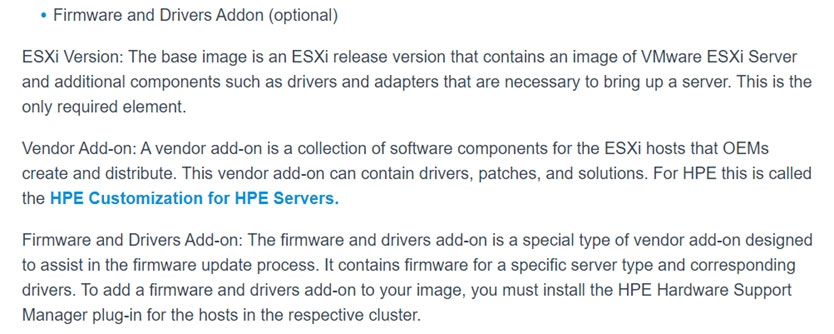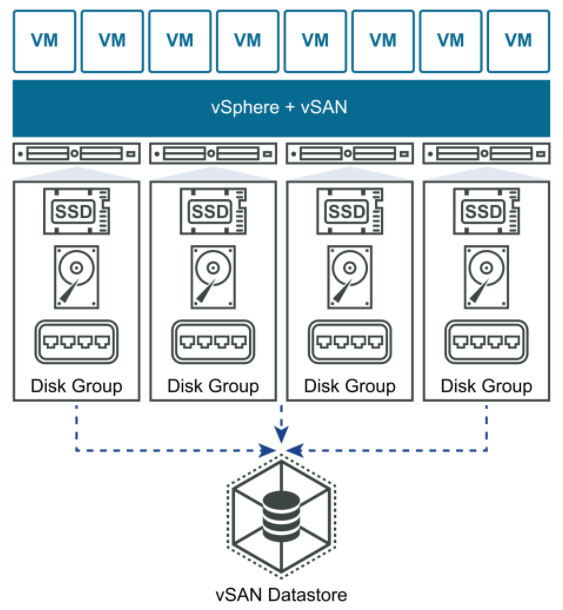A vSAN administrator received the following alert from vRealize Operations Manager:
`VMKernel NIC is experiencing high number of dropped packets.`
What is the quickest path in vRealize Operations Manager that should be used to further investigate this alert?
C
Reference:
https://www.viktorious.nl/2015/12/10/vrops-virtual-machine-is-experiencing-a-high-number-of-received-packet-drops/
A single capacity disk fails within a vSAN 7.0 U1 cluster running with a `compression-only` configuration enabled. The vSAN administrator must recognize the platform impact that has occurred and take steps to correct it.
Which action should the vSAN administrator take?
D
Reference:
https://blogs.vmware.com/virtualblocks/2020/09/22/space-efficiency-using-the-new-compression-only-option-in-vsan-7-u1/
A vSAN administrator of a network isolated vSAN environment wants to upgrade the environment from the vSAN 7.0 to the vSAN 7.0 U1 using vLCM.
Which option, if any, should be used as a depot in this case?
D
Reference:
https://kb.vmware.com/s/article/80838
An organization wants to configure a new storage policy based on the following requirements:
✑ Failures to tolerate = FTT 1/RAID-5 (Erasure Coding)
✑ Number of disk stripes per object = 8
✑ IOPS limit for object = 0
✑ Object Space Reservation = Thin provisioning
✑ Flash read cache reservation = 0%
✑ Disable object checksum = No
✑ Force provisioning = No
The administrator creates the policy using storage policy based management and assigns it to a 100GB virtual machine on a 4-node vSAN cluster to test the results of the new storage policy.
How many components will be created per host for the storage objects of the virtual machine on the vSAN datastore?
B
A vSphere administrator wants to use vSphere Lifecycle Manager (vLCM) to manage a vSAN cluster with one desired image. When creating the new cluster, the administrator chooses `Manage all hosts in the cluster with a single image`.
Which option is NOT available when setting up the cluster image?
D
Reference:
https://blogs.vmware.com/virtualblocks/2020/06/02/vsphere-lifecycle-manager-on-hpe/
Which vSAN advanced setting can be adjusted to avoid rebuild operations during a host hardware maintenance window that is expected to exceed 90 minutes?
C
Reference:
https://blogs.vmware.com/virtualblocks/2018/10/29/a-closer-look-at-emm/#:~:text=Object%20Repair%20Timer,absent%20objects%20on%20remaining
%20hosts
The DevOps team of an organization wants to deploy their new cloud native application with persistent storage on a dedicated vSAN cluster. The storage administrator is tasked to configure the vSAN cluster and leverage the vSAN Direct feature.
Which two requirements must the administrator meet to complete this task? (Choose two.)
BE
Reference:
https://core.vmware.com/blog/understanding-vsan-data-persistence-platform
What os the maximum number of 2-node clusters that can share a vSAN Shared Witness host in vSAN 7.0 U1?
A
Reference:
https://esxsi.com/2021/01/29/vsan7-install-2/
An administrator is enabling vSphere HA and vSAN on the same cluster and needs to use a configuration that is valid for vSphere HA Heartbeat datastore.
Which configuration should be used?
C
Reference:
https://kb.vmware.com/s/article/83177
An administrator has been tasked with physically moving the hosts in a vSAN 7.0 U1 cluster to an alternative location. All virtual machines, hosts, and the vCenter
Server have need safely powered sown, and the servers have been relocated. Afterwards, the operations engineer needs to bring up the vSAN cluster again.
Which action is part of this process?
B
Reference:
https://docs.vmware.com/en/VMware-vSphere/7.0/com.vmware.vsphere.vsan-monitoring.doc/GUID-31B4F958-30A9-4BEC-819E-32A18A685688.html